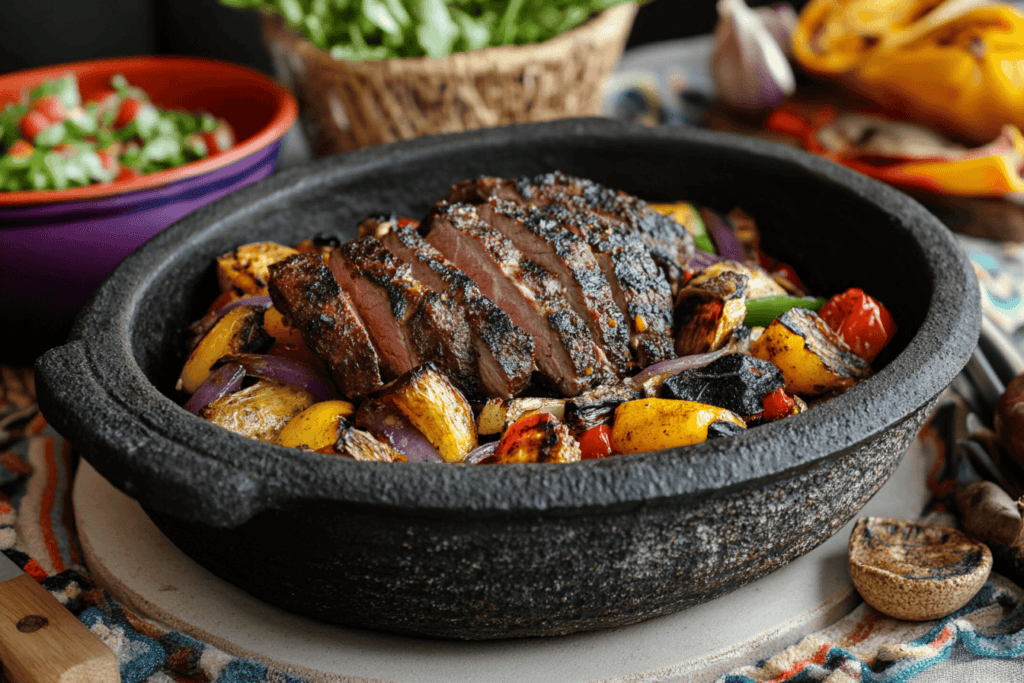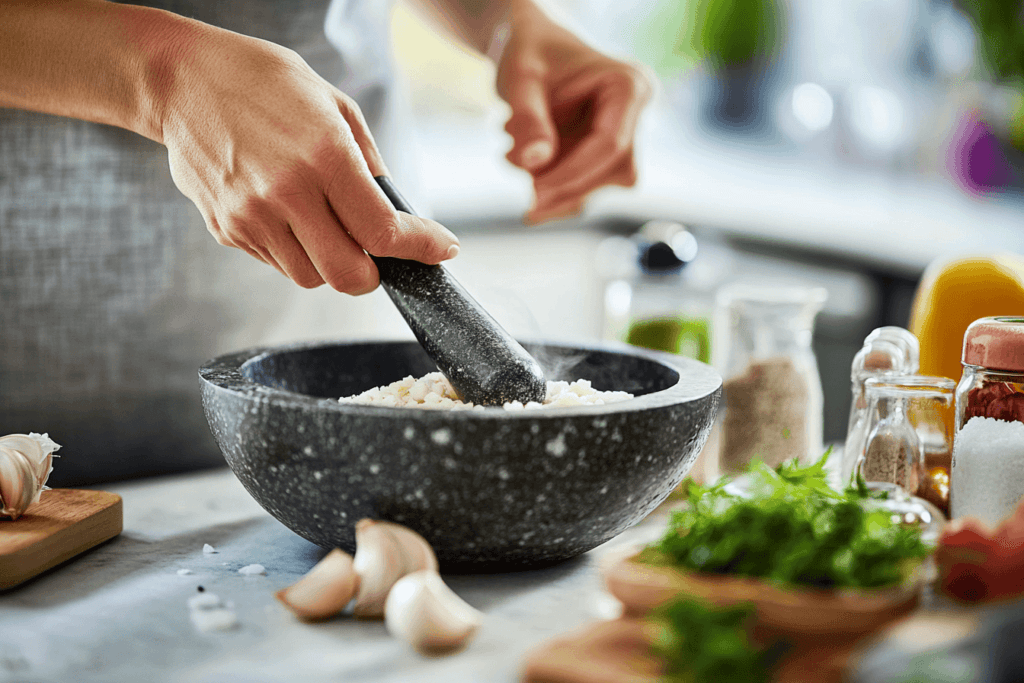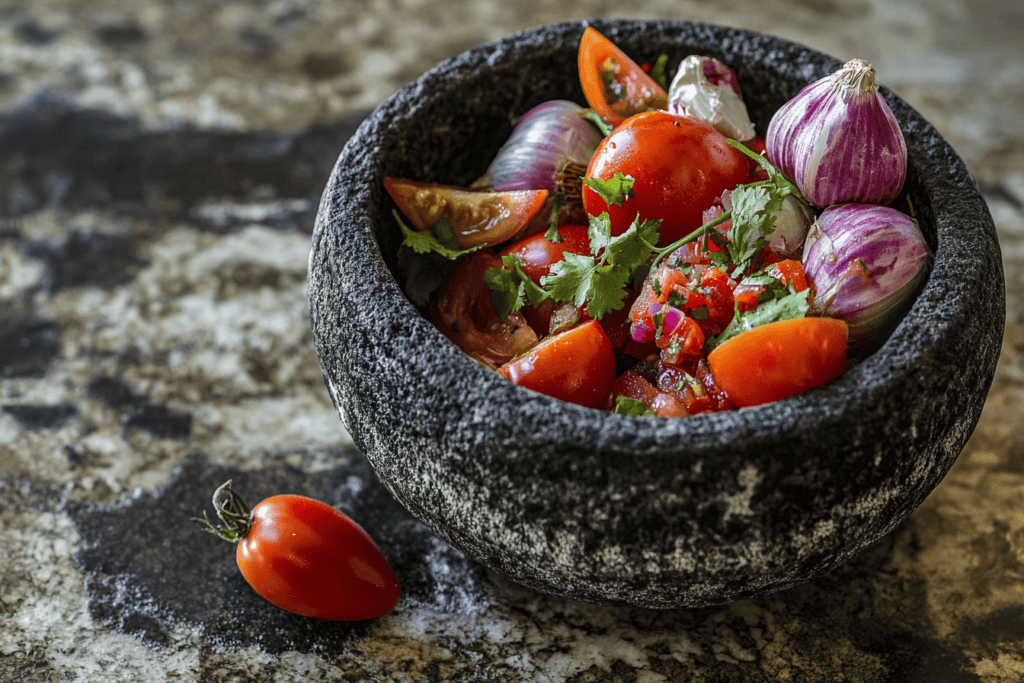
Cooking connects people to culture and history, and the molcajete represents this beautifully. This traditional Mexican tool grinds and blends ingredients by hand, and cooks have relied on it for centuries. Even today, it remains popular because it enhances fresh, bold flavors.
What is a Molcajete?
A molcajete consists of a bowl-shaped mortar made from volcanic rock and a matching pestle called a tejolote. Cooks use its rough surface to grind spices, herbs, and vegetables into flavorful pastes and sauces.
Importance of Traditional Cooking Tools
Why rely on a traditional molcajete when modern kitchen appliances offer more convenience? The answer lies in its ability to release and blend flavors naturally. Unlike blenders, which can overheat and alter textures, the molcajete mimics the ancient grinding techniques of hand-crushing. This makes it perfect for producing authentic Mexican salsas, guacamole, and spice blends, preserving cultural authenticity in every meal.
Essentials for a Molcajete
To make the most of your molcajete, it’s essential to understand the type of ingredients that work best with this traditional tool. The rough volcanic stone surface is ideal for grinding, mashing, and blending a variety of fresh, dry, and semi-wet ingredients.
Traditional Ingredients for a Molcajete
The molcajete is deeply tied to Mexican cuisine, with its ingredients showcasing the country’s rich culinary heritage. Here are some staples:
- Garlic: This adds bold flavor and grinds easily into a smooth paste.
- Chiles: Whether fresh or dried, chiles form the base of many sauces.
- Tomatoes and Tomatillos: These are staples for making red and green salsas.
- Onions: They crush well and blend perfectly with other ingredients.
Key Spices and Seasonings
Next, consider the spices. A molcajete is excellent for grinding spices and releasing their natural oils. For example:
- Cumin and Coriander: These spices are often paired to create earthy flavors.
- Salt: Coarse salt not only enhances flavor but also helps with grinding.
- Peppercorns: Freshly ground pepper adds sharpness and depth to any dish.

Fresh Produce Commonly Used
The molcajete works especially well with fresh ingredients, which means you can make flavorful and healthy dishes. For instance:
- Avocados: These are essential for making creamy guacamole.
- Cilantro: This herb adds a fresh, zesty taste to any recipe.
- Lime Juice: Although not ground directly, lime is often added for its tangy kick.
- Fruits: Sweet options like mangoes or pineapples can be used to create unique salsas.
Combining Ingredients for Maximum Flavor
One of the greatest advantages of a molcajete is its ability to combine flavors naturally. For example, when making salsa, the grinding process crushes chiles, garlic, and tomatoes together, releasing their juices and oils in a way that amplifies their taste. The result? A rich and authentic flavor you simply can’t replicate with a blender.
Common Dishes Made with a Molcajete
The molcajete’s versatility makes it an essential tool for crafting authentic Mexican dishes. It’s not just about grinding ingredients; it’s about unlocking rich, authentic flavors that enhance the culinary experience. Here are some popular dishes that showcase the molcajete’s capabilities.
Salsas: A Staple in Mexican Cuisine
Salsas are the most iconic creations made with a molcajete. Crushing ingredients by hand produces a rustic texture and depth of flavor that’s hard to achieve with modern appliances.
Red Salsa (Salsa Roja)
This classic salsa is made by grinding roasted tomatoes, chiles, garlic, and onions. A pinch of salt and cilantro completes the recipe. The molcajete’s rough surface blends the ingredients into a chunky, aromatic sauce that pairs perfectly with tacos, grilled meats, or tortilla chips.
Green Salsa (Salsa Verde)
Using tomatillos instead of tomatoes, this tangy green salsa combines roasted tomatillos, fresh cilantro, onions, and serrano chiles. The molcajete ensures that the salsa retains a balance of tartness and spice.
Pico de Gallo
While typically diced, pico de gallo can also be lightly mashed in a molcajete to release the juices of tomatoes, onions, and lime, creating a slightly saucier version of this fresh condiment.
Guacamole: A Classic Example
Another popular dish made with a molcajete is guacamole. Crushing avocados by hand creates a creamy yet slightly chunky texture. Then, mixing in garlic, lime juice, tomatoes, and onions brings out all the fresh flavors. As a result, guacamole prepared in a molcajete is hard to beat.
Traditional Guacamole Recipe
- Start by grinding garlic and salt together in the molcajete to form a paste.
- Add avocados and mash them to your desired consistency.
- Mix in diced tomatoes, onions, cilantro, and lime juice.
- Optional: Add a pinch of cumin or jalapeños for extra flavor.
The result is a guacamole bursting with flavor and rustic charm, ideal for dipping or spreading.
Spice Mixes and Marinades
The molcajete isn’t limited to salsas and guacamole; it’s also an excellent tool for making spice blends and marinades.
Adobo Marinade
Adobo, a rich Mexican marinade, is crafted by blending dried chiles, garlic, cumin, vinegar, and spices into a thick paste. The molcajete grinds the dried chiles into powder while releasing their oils, creating a marinade that’s perfect for meats like pork or chicken.
Mole Base
While mole is a complex dish, the molcajete is often used in the early stages to crush roasted nuts, seeds, and dried chiles into a smooth base. This method enhances the depth of flavor in this iconic sauce.
Specialty Dishes Made with a Molcajete
Some Mexican restaurants serve dishes directly in a heated molcajete, using it as a serving vessel to retain warmth and authenticity. Examples include:
- Molcajete Mixto: A mixed platter of grilled meats, cactus, and cheese served in a hot molcajete.
- Seafood Molcajete: A combination of shrimp, fish, and spices served bubbling hot in the stone bowl.
The use of the molcajete adds a unique flair to the presentation, making the dish as visually appealing as it is delicious.
How to Use a Molcajete Properly
Although using a molcajete is simple, following these steps will help you get the best results.
Preparing the Molcajete Before Use
Seasoning Your Molcajete
Before its first use, it’s essential to season a new molcajete. Start by grinding uncooked rice until it turns into a fine powder. This removes grit and smooths the surface. Afterward, grind garlic into a paste and coat the interior. Allow it to sit for a day before rinsing with warm water:
- Rinse Thoroughly: Wash the molcajete and pestle with warm water—avoid soap, as it can leave residues in the stone.
- Grind Rice: Add a handful of uncooked white rice and grind it into a fine powder. This helps smooth out the surface and remove any remaining debris.
- Repeat: Discard the powdered rice and repeat the process until the rice powder appears clean and free of grit.
- Add Garlic Paste: Grind a few cloves of garlic into a paste, spreading it across the entire surface. Let it sit for 24 hours to allow the garlic oils to penetrate the stone.
- Rinse Again: Rinse thoroughly with warm water and let the molcajete air dry.
This process ensures your molcajete is free of grit and ready to impart its unique flavors to your ingredients.
Grinding Techniques for Best Results
Grinding in a molcajete is a tactile process that requires patience and the right technique. Here’s how to do it properly:
Crushing Ingredients
- Start with coarse ingredients like salt or whole spices to create a solid grinding base.
- Use a circular or back-and-forth motion with the pestle (tejolote) to grind the ingredients.
- Apply consistent pressure but avoid being too aggressive, as this can crush delicate ingredients too finely.
Building Layers of Flavor
- Add ingredients in stages, starting with the hardest items (like garlic or dried chiles) and finishing with softer ones (like tomatoes or avocados).
- This method ensures each layer is thoroughly blended, creating a harmonious flavor profile.
Achieving Desired Texture
- For salsas, grind to a coarse or chunky texture for a rustic, authentic look.
- For spice mixes or marinades, grind longer for a finer consistency.

Maintenance Tips for Longevity
To keep your molcajete in excellent condition, proper care and maintenance are essential:
Cleaning After Use
- Avoid Soap: Clean your molcajete with warm water and a stiff brush or sponge to prevent soap residue from seeping into the stone.
- Rinse Immediately: Don’t let food particles dry in the molcajete, as they can become difficult to remove.
- Air Dry: Allow the molcajete to dry completely before storing to prevent mold or mildew.
Storing Your Molcajete
- Keep your molcajete in a dry place to avoid moisture build-up.
- If storing for a long time, cover it with a clean cloth to prevent dust accumulation.
Re-Seasoning When Necessary
- Over time, your molcajete may require re-seasoning, especially if it hasn’t been used for a while. Repeat the initial seasoning steps with rice and garlic to refresh the surface.
Common Mistakes to Avoid
- Using Abrasive Cleaners: Harsh scrubbing pads or detergents can damage the stone surface.
- Grinding Wet Ingredients First: Always grind dry ingredients first to prime the surface for softer items.
- Ignoring Cracks: If your molcajete develops cracks, it may no longer be safe to use. Inspect regularly for any signs of damage.
Mastering the molcajete not only preserves its longevity but also ensures every dish you make is as authentic and flavorful as possible.
FAQs
Here are some of the most frequently asked questions about the molcajete, its uses, and how to care for it effectively.
What do you put in a molcajete?
A molcajete is incredibly versatile. It is traditionally used to prepare and serve bold and flavorful dishes like grilled meats, roasted vegetables, and salsa. For an authentic Mexican experience, explore our guide on creating a molcajete dish bursting with flavors. You’ll find ideas for proteins like beef, chicken, shrimp, and even vegetarian or seafood variations.
What is the best way to season a molcajete?
To season a molcajete, grind a handful of uncooked rice into a fine powder. This process smooths and cleans the stone’s surface. Next, crush garlic into a paste, spread it across the bowl, and let it sit for 24 hours. Rinse with warm water, and it’s ready to use.
Can you use a molcajete for non-Mexican dishes?
Absolutely! A molcajete can be used for diverse recipes. Prepare pesto, curry pastes, or spice blends for various cuisines. If you’re looking for additional inspiration, learn more about creative ways to serve alongside traditional recipes.
How do you clean a molcajete after use?
Cleaning a molcajete is easy—just use warm water and a stiff brush or sponge. Avoid soap, as it can absorb into the stone and affect the flavor of future meals. Rinse well and let it air dry completely before storing. For more tips on maintaining your kitchen tools, check out ways to extend their lifespan
Is a molcajete better than a modern blender or food processor?
A molcajete stands out because it grinds ingredients slowly and naturally, releasing oils and enhancing flavors. Blenders are faster but often alter the texture and taste. For those who value authentic flavors, a molcajete is the best choice.
What types of stone are best for a molcajete?
Molcajetes are traditionally made from volcanic basalt, known for its durability and rough texture ideal for grinding. Be wary of imitations made from concrete or other materials, as they may not perform as well and could leach harmful substances into food.
Can you grind nuts or seeds in a molcajete?
Yes! A molcajete is perfect for grinding nuts and seeds. Whether you’re preparing nut butter, tahini, or spice blends, its textured surface allows for precise control over the texture, from coarse to smooth.
Conclusion
The molcajete is more than just a kitchen tool—it’s a symbol of culinary heritage and craftsmanship. By learning how to use it properly and experimenting with its endless possibilities, you can bring the authentic flavors of Mexican cuisine to life while exploring creative uses beyond traditional recipes. Whether you’re making salsa, grinding spices, or presenting a sizzling dish, the molcajete remains a timeless addition to any kitchen.
